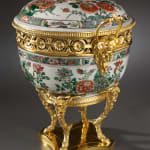Henry Dasson
A wonderful and rare gilt bronze mounted Chinese late Kangxi period porcelain bowl with lid,
signed on the gilt bronze mounts Henry Dasson, 1885
The porcelain: China, late Kangxi period, date circa 1700-25.
Height 38cm, Diameter 23cm
Henry Dasson, one of the eminent bronziers and ébénistes of the second half of the 19th century, produced both replicas from the 18th century and also works of art inspired by the finest creations of the previous century.
Henry Dasson, the son of Jean-Baptiste, a cobber, was born in Paris on 10th May 1825. He began his career as a clockmaker at Rue Nonnains-d'Hyêres and by 1854 he married and set up business at Rue Saint-Louis au Marais, a favoured location for craftsmen. By the 1860's he had formed a partnership with Godet as a clock and bronze manufacturer. This continues until he purchased Charles Winckelsein's renowned furniture business from his widow in 1871. This meant that he was able to add the art of the ébénisterie to his production of bronzes and clocks. He was now trading under the name Dasson et Cie, based at the Rue Vielle-du-Temple, where he was to remain until the business closed in 1894.
He was to become one of the most eminent bronze and furniture makers of the second half of the 19th century specialising in furniture in the Louis XVI style and received many important commissions such as producing a replica of the bureau du Roi made for Louis XV by Jean-François Oeben and completed by Riesener, which was in the Louvre. This was shown at the Exposition Universelle of 1878 and purchased by Lady Ashburton for 90,000 francs. It is thought that he also produced a second copy for the King of the Belgians. At the same exhibition he displayed a particularly fine table which was purchased by Lord Dudley. By this time he was capable of producing the finest work which attracted an important clientele such as Baron Ferdinand Rothschild.
As a result of his contribution to the arte, Dasson was nominated 'Chevalier de l'Ordre de la Legion d'Honneur' in 1883 and six years later was made a Grande Officier. He died in 1896 and was buried at the cemetery of Père-Lachaise, Paris, where his tombstone was surmounted by a portrait bust by Jules Dallier.



